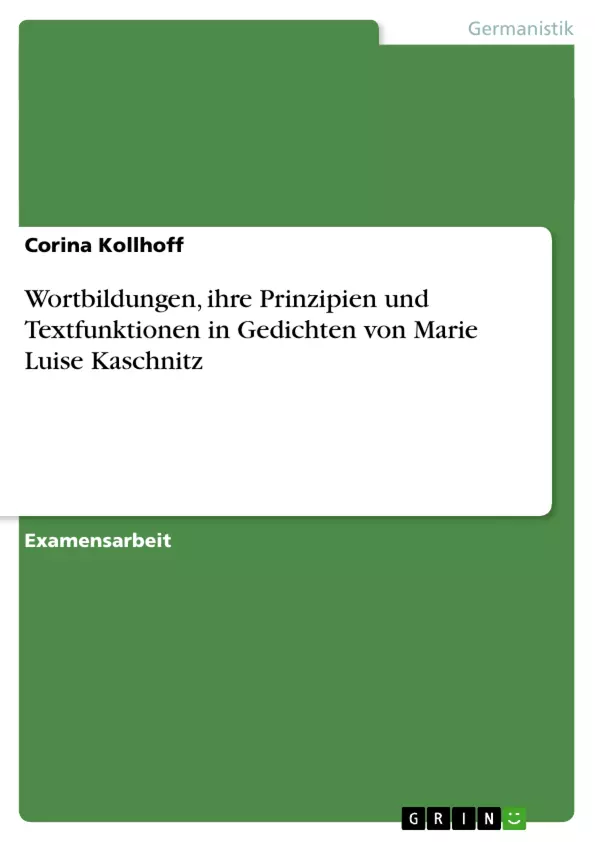Der Textkorpus der morphologischen Analyse umfasst dreißig Gedichte aus dem lyrischen Gesamtwerk von Marie Luise Kaschnitz. Da hier nur ein geringer Teil der von Marie Luise Kaschnitz verfassten Gedichte untersucht wird, bietet die Analyse zwar einen Einblick in die Art und Weise der Verwendung von Wortbildungen, ist aber nicht für ihr lyrisches Gesamtwerk repräsentativ.
Nach der Einleitung erfolgt zunächst eine theoretische Darstellung der Wortbildungsmorphologie. Hierbei sollen zum einen die verschiedenen Wortbildungstypen vorgestellt und definiert und zum anderen die Divergenzen der Wortbildungsforschung gegenübergestellt werden. Die
Grundlagen fußen dabei auf den Arbeiten von SIMMLER (1998), FLEISCHER/BARZ (1995), ERBEN (2000) und WELLMANN (1998). Es wird im Wesentlichen der Wortbildungstheorie von SIMMLER gefolgt.
Anhand dieser Grundlagen werden zu den verschiedenen Wortbildungstypen die Prinzipien und teilweise schon die Funktionen der Wortbildungen in den Gedichten
dargestellt. Dieses Verfahren bietet die Möglichkeit, die vorgestellte Theorie zu belegen und mit Beispielen zu verdeutlichen. Die angeführten Beispiele und die Darstellungen in den Tabellen haben keinen Anspruch auf Vollständigkeit.
Bevor im dritten Kapitel mit der Untersuchung der einzelnen Gedichte begonnen wird, erfolgt zunächst eine kurze Textsortendefinition anhand des vorhandenen Textmaterials. Nach den einzelnen Gedichtanalysen wird soweit vorhanden ein Vergleich mit den literaturwissenschaftlichen Interpretationsergebnissen vorgenommen. Die Ergebnisse aller Gedichte werden im Schlussteil zusammengefasst und gegenübergestellt.
Ziel der Arbeit ist es, Regelmäßigkeiten und Unregelmäßigkeiten in der Verwendung der Wortbildungen der untersuchten Gedichte aufzuzeigen. Dabei sollen zum einen die allgemeinen Prinzipien und zum anderen die Funktionen der einzelnen Wortbildungen wiedergegeben werden. Zur Darstellung der Prinzipien wird der gesamte Textkorpus herangezogen. Die Funktionen der Wortbildungen werden zunächst in Bezug auf das
entsprechende Gedicht bzw. die entsprechende Strophe betrachtet und sollen schließlich in der Auswertung aller Gedichte verglichen werden.
Inhaltsverzeichnis
- 1 Einleitung
- 2 Wortbildungsmorphologie
- 2.1 Kompositionen
- 2.1.1 Kompositionstypen
- 2.1.2 Kompositionsähnliche Strukturen
- 2.1.2.1 Affixoidbildungen
- 2.1.2.2 Dekomposition
- 2.1.2.3 Pseudokomposition
- 2.1.2.4 Zusammenbildung
- 2.1.2.5 Zusammenrückung
- 2.2 Derivationen
- 2.2.1 Präfixbildungen
- 2.2.2 Suffixbildungen
- 2.2.3 Präfix-/Suffixbildungen
- 2.3 Konversion
- 3 Untersuchung der Gedichte
- 3.1 Gedicht 1 - Abschied von Rom
- 3.1.1 Textgrundlage
- 3.1.2 Textanalyse
- 3.2 Gedicht 2 – Ahasver
- 3.2.1 Textgrundlage
- 3.2.2 Textanalyse
- 3.3 Gedicht 3 - Am Feiertag
- 3.3.1 Textgrundlage
- 3.3.2 Textanalyse
- 3.4 Gedicht 4 - Castellezlandschaft
- 3.4.1 Textgrundlage
- 3.4.2 Textanalyse
- 3.5 Gedicht 5 - Charon
- 3.5.1 Textgrundlage
- 3.5.2 Textanalyse
- 3.6 Gedicht 6 - Der Mensch
- 3.6.1 Textgrundlage
- 3.6.2 Textanalyse
- 3.7 Gedicht 7 - Die Gärten
- 3.7.1 Textgrundlage
- 3.7.2 Textanalyse
- 3.8 Gedicht 8 - Die Katze
- 3.8.1 Textgrundlage
- 3.8.2 Textanalyse
- 3.9 Gedicht 9 - Die Wolke
- 3.9.1 Textgrundlage
- 3.9.2 Textanalyse
- 3.10 Gedicht 10 - Ebenenher
- 3.10.1 Textgrundlage
- 3.10.2 Textanalyse
- 3.11 Gedicht 11 – Ein Leben nach dem Tode
- 3.11.1 Textgrundlage
- 3.11.2 Textanalyse
- 3.12 Gedicht 12 - Einfälle
- 3.12.1 Textgrundlage
- 3.12.2 Textanalyse
- 3.13 Gedicht 13 - Erde
- 3.13.1 Textgrundlage
- 3.13.2 Textanalyse
- 3.14 Gedicht 14 - Exotarium
- 3.14.1 Textgrundlage
- 3.14.2 Textanalyse
- 3.15 Gedicht 15 - Gleichzeitig
- 3.15.1 Textgrundlage
- 3.15.2 Textanalyse
- 3.16 Gedicht 16 – Grabstele
- 3.16.1 Textgrundlage
- 3.16.2 Textanalyse
- 3.17 Gedicht 17 - Heute 1
- 3.17.1 Textgrundlage
- 3.17.2 Textanalyse
- 3.18 Gedicht 18 – Hiroshima
- 3.18.1 Textgrundlage
- 3.18.2 Textanalyse
- 3.19 Gedicht 19 - Interview
- 3.19.1 Textgrundlage
- 3.19.2 Textanalyse
- 3.20 Gedicht 20 - Jeder
- 3.20.1 Textgrundlage
- 3.20.2 Textanalyse
- 3.21 Gedicht 21 – Juni
- 3.21.1 Textgrundlage
- 3.21.2 Textanalyse
- 3.22 Gedicht 22 – Machandelbaum
- 3.22.1 Textgrundlage
- 3.22.2 Textanalyse
- 3.23 Gedicht 23 – Märzschnee in München
- 3.23.1 Textgrundlage
- 3.23.2 Textanalyse
- 3.24 Gedicht 24 – Müllabfuhr
- 3.24.1 Textgrundlage
- 3.24.2 Textanalyse
- 3.25 Gedicht 25 – Nausikaa
- 3.25.1 Textgrundlage
- 3.25.2 Textanalyse
- 3.26 Gedicht 26 - Nicht aus Erde
- 3.26.1 Textgrundlage
- 3.26.2 Textanalyse
- 3.27 Gedicht 27 – Palermo
- 3.27.1 Textgrundlage
- 3.27.2 Textanalyse
- 3.28 Gedicht 28 - Rom 1961
- 3.28.1 Textgrundlage
- 3.28.2 Textanalyse
- 3.29 Gedicht 29 - Selbstbildnis mit sechzig Jahren
- 3.29.1 Textgrundlage
- 3.29.2 Textanalyse
- 3.30 Gedicht 30 – Zumutungen
- 3.30.1 Textgrundlage
- 3.30.2 Textanalyse
- Die Rolle der Wortbildung in der Gestaltung von Bedeutung und Ausdruck
- Die Verwendung verschiedener Wortbildungsstrategien und ihre Auswirkungen auf den Text
- Die Beziehung zwischen Wortbildung und den Themen und Motiven in den Gedichten
- Die Bedeutung der Wortbildung für die Poetik von Marie Luise Kaschnitz
Zielsetzung und Themenschwerpunkte
Diese wissenschaftliche Hausarbeit befasst sich mit der Analyse von Wortbildungen in Gedichten von Marie Luise Kaschnitz. Sie zielt darauf ab, die Prinzipien und Textfunktionen der Wortbildung in den Gedichten zu untersuchen.
Zusammenfassung der Kapitel
Das erste Kapitel bietet eine Einführung in das Thema der Wortbildung und erläutert die wissenschaftliche Methode der Untersuchung. Das zweite Kapitel analysiert die wichtigsten Wortbildungsstrategien, wie Kompositionen, Derivationen und Konversionen, und ihre typologische Einordnung. Das dritte Kapitel befasst sich mit der detaillierten Analyse der Gedichte von Marie Luise Kaschnitz, wobei in jedem Abschnitt die jeweiligen Wortbildungsstrategien und deren Funktionen im Text untersucht werden. Dieses Kapitel enthält jedoch keine Zusammenfassung des Schluss- oder Finalkapitels.
Schlüsselwörter
Wortbildung, Morphologie, Komposition, Derivation, Konversion, Poetik, Bedeutung, Ausdruck, Textfunktion, Marie Luise Kaschnitz, Gedichtanalyse
- Quote paper
- Corina Kollhoff (Author), 2006, Wortbildungen, ihre Prinzipien und Textfunktionen in Gedichten von Marie Luise Kaschnitz, Munich, GRIN Verlag, https://www.grin.com/document/89134



